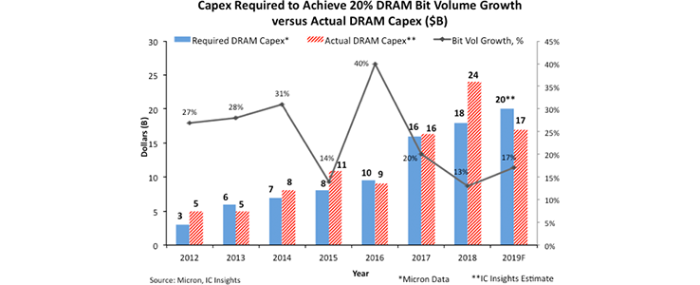
© IC Insights
Analysis |
DRAM Capex to plunge 28% in 2019
One of the significant questions facing the IC industry in the second half of 2019 is if and when the DRAM market will rebound.
Any rebound in the market will be driven in part by available manufacturing capacity. After huge capex outlays for DRAM in 2017 and 2018, the question becomes how much new capacity will come online and how far DRAM prices (price per bit) will fall as a result of this buildup.
The three main DRAM suppliers—Samsung, SK Hynix, and Micron—generally agree that DRAM bit volume will grow roughly 20% per year over the next few years.
With new and very complex DRAM technologies requiring much more fab equipment and more fab space needed to house this equipment, Micron estimates that the industry capex required to grow DRAM bit volume by 20% more than doubled from $8 billion in 2015 to $18 billion in 2018! Actual DRAM expenditures in 2016 were slightly below what was needed to increase bit volume 20% and about equal to what was needed in 2017. However, in 2018, capex targeting the DRAM market reached $23.7 billion, 32% more than the $18.0 billion that was deemed necessary to grow DRAM bit volume by 20%. It is worth noting that in 2018, DRAM bit volume increased only 13% and is forecast to increase 17% in 2019, market researcher IC Insights remarks in a press release.
Too much capex spending typically leads to overcapacity and subsequent pricing weakness—a condition that is amplified by economic weakness and softer demand from end-users. With Samsung, SK Hynix, and Micron aggressively spending to upgrade/add DRAM capacity last year, and with economic and trade uncertainties continuing to permeate global markets, IC Insights believes that the risk of too much DRAM capacity and the subsequent pricing weakness that results will continue for the remainder of 2019. On a brighter note, actual DRAM capex spending in 2019 is forecast to be less than what is required to maintain 20% bit volume growth. That could offset the overspending in 2018 and help start a return to supply-demand balance within the DRAM market in 2020.
More information can be found here.
More information can be found here.




